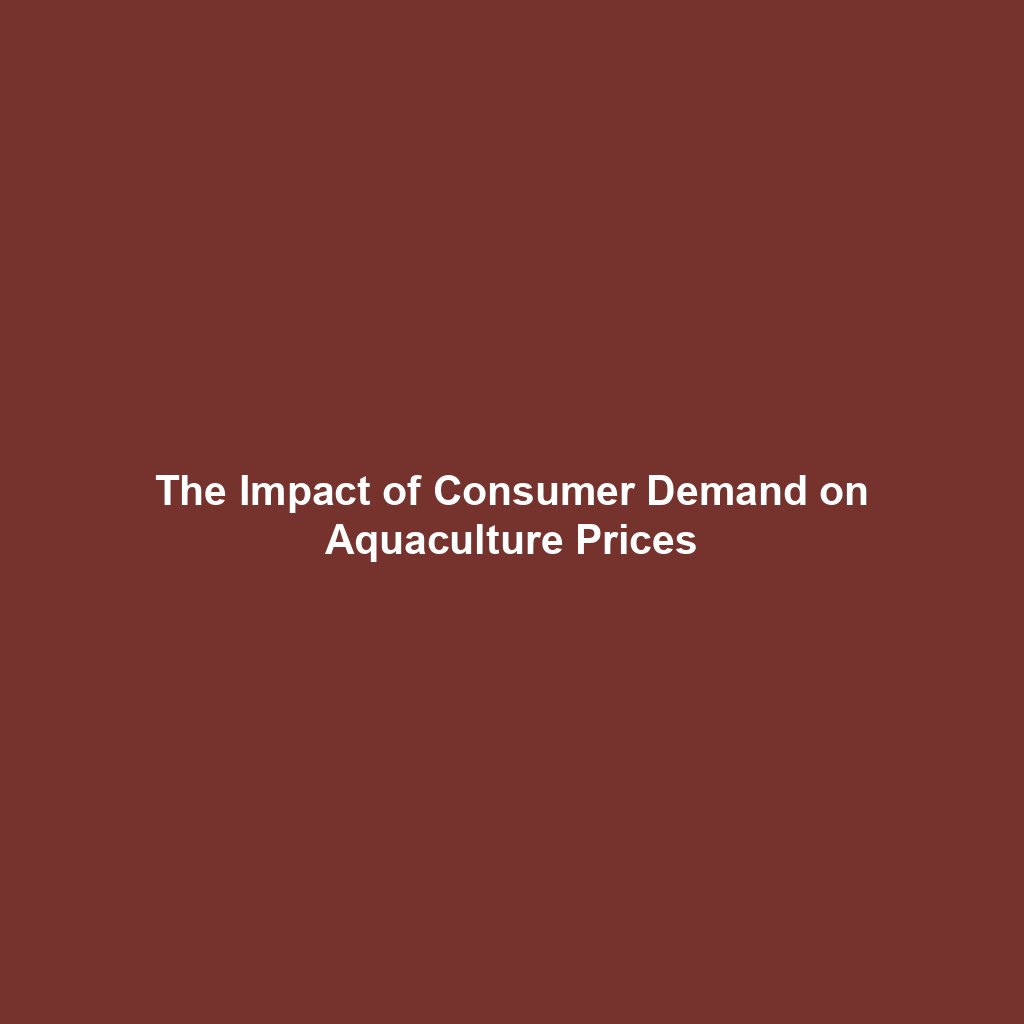
Introduction
Aquaculture, the farming of aquatic organisms such as fish, crustaceans, mollusks, and aquatic plants, has become a significant sector in global food production. As consumer demand for seafood continues to rise, understanding the impact of this demand on aquaculture prices is crucial for stakeholders, including farmers, distributors, and policymakers. This article delves into the intricate relationship between consumer demand and aquaculture prices, exploring various factors that influence this dynamic and offering insights into effective price analysis.
Chapter 1: The Dynamics of Consumer Demand in Aquaculture
1.1 The Growth of Aquaculture
Over the past few decades, aquaculture has experienced exponential growth, driven by the increasing global population and the rising demand for protein-rich foods. According to the Food and Agriculture Organization (FAO), aquaculture now accounts for nearly half of the world’s fish supply, a significant increase from just a few decades ago. This growth is not only a response to the overfishing of wild stocks but also a reflection of changing consumer preferences towards healthier and more sustainable food options.
1.2 Factors Influencing Consumer Demand
Several factors influence consumer demand for aquaculture products, including:
- Health Awareness: As consumers become more health-conscious, the demand for seafood, which is often perceived as a healthier alternative to red meat, has surged. Omega-3 fatty acids, found in many fish species, are particularly sought after for their health benefits.
- Sustainability Concerns: Environmental awareness has led consumers to prefer sustainably farmed seafood. Certifications and eco-labels play a significant role in guiding consumer choices.
- Economic Factors: Disposable income and economic stability directly impact consumer purchasing power. In times of economic prosperity, consumers are more likely to spend on premium seafood products.
- Cultural Preferences: Cultural and regional preferences significantly influence seafood consumption patterns. For instance, countries with a strong tradition of seafood consumption, such as Japan and Norway, exhibit higher demand.
- Technological Advancements: Innovations in aquaculture technology have made it possible to farm a wider variety of species, meeting diverse consumer preferences and expanding market reach.
1.3 Seasonal Variations and Demand
Seasonal variations also play a crucial role in consumer demand for aquaculture products. For example, demand for certain species may spike during festive seasons or holidays. Understanding these patterns helps producers and distributors plan their supply chains more effectively, ensuring that they can meet peak demand without causing price volatility.
Chapter 2: Analyzing Aquaculture Prices
2.1 Price Determinants in Aquaculture
The price of aquaculture products is influenced by a myriad of factors, including production costs, market demand, and external economic conditions. Key determinants include:
- Production Costs: These encompass feed, labor, energy, and maintenance costs. Fluctuations in any of these components can significantly impact the final price of aquaculture products.
- Supply Chain Efficiency: Efficient logistics and distribution networks help in reducing costs and ensuring timely delivery, which can stabilize prices.
- Market Demand: As discussed earlier, consumer demand directly influences prices. High demand typically drives prices up, while low demand can lead to price drops.
- Regulatory Environment: Government policies, including subsidies, tariffs, and import/export regulations, can affect production costs and market prices.
- Global Trade Dynamics: International trade agreements and geopolitical factors can influence the availability and price of aquaculture products in different markets.
2.2 Price Elasticity of Demand
Price elasticity of demand measures how sensitive the quantity demanded of a product is to changes in its price. In the context of aquaculture, understanding price elasticity helps producers and marketers predict how changes in price will affect consumer purchasing behavior. For instance, if a particular species of fish has high price elasticity, a small increase in price could lead to a significant drop in demand. Conversely, products with low price elasticity may see stable demand even with price fluctuations.
2.3 Market Segmentation and Pricing Strategies
Effective market segmentation allows producers to tailor their pricing strategies to different consumer groups. For example, premium pricing can be applied to high-quality, sustainably farmed seafood targeting health-conscious consumers, while more affordable options can cater to price-sensitive segments. Dynamic pricing strategies, which adjust prices based on real-time demand and supply conditions, can also be employed to optimize revenue.
2.4 The Role of Data Analytics in Price Analysis
Data analytics plays a pivotal role in modern price analysis. By leveraging big data and advanced analytics tools, producers and marketers can gain deeper insights into consumer behavior, market trends, and price dynamics. Predictive analytics can forecast future demand and price movements, enabling more informed decision-making. Additionally, real-time data monitoring helps in identifying and responding to market changes promptly.
2.5 Case Studies and Real-World Examples
Examining real-world examples and case studies provides valuable insights into the practical application of price analysis in aquaculture. For instance, the Norwegian salmon industry has successfully utilized data analytics and dynamic pricing strategies to navigate market fluctuations and maintain profitability. Similarly, the shrimp farming sector in Southeast Asia has adopted innovative production techniques and market segmentation to meet diverse consumer demands and stabilize prices.
Conclusion
Understanding the impact of consumer demand on aquaculture prices is essential for the sustainable growth of the industry. By analyzing the various factors that influence demand and employing effective price analysis techniques, stakeholders can make informed decisions that benefit both producers and consumers. As the aquaculture sector continues to evolve, staying attuned to market dynamics and leveraging advanced analytics will be key to navigating the complexities of pricing and ensuring long-term success.



